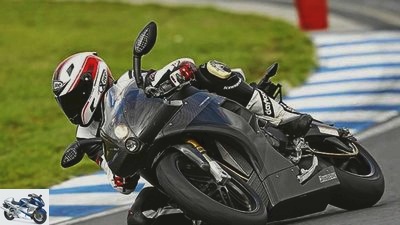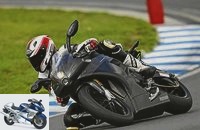Menus

fact
Driving report: EBR 1190 RS
Erik Buell’s super athlete
The dead live longer. With the EBR 1190 RS, Erik Buell delivers an impressive sign of life. MOTORRAD drove the first copy to land in Europe in Oschersleben.
Erik Buell will certainly not forget September 4th anytime soon. On that day, two EBR 1190 RS fought for sixth and seventh place at the AMA Superbike race in New Jersey.
EBR stands for Erik Buell Racing. After the demise of his brand, Buell wants to regain a foothold in motorcycle business under this abbreviation. And the EBR 1190 RS is the first step towards it.
It is already available in America. Even though there will only be 100 of them. But now the first copy came across the pond. Jens Kruper, team boss and technical mastermind of the Pegasus Race Team (www.pegasusraceteam.com), and team owner Thomas Wanner, who brought the EWC to Europe, are initially planning the homologation for Switzerland. If that is done, other countries like Germany can follow suit.
At first glance, the EWC looks like a Buell 1125 with slim cladding. Chubby aluminum bridge frame, the mighty profiles of which serve as a tank, but now only hold 17 instead of the previous 21 liters. Swing arm with directly hinged strut. As far as everything as usual. The steering head angle is one degree flatter at 68 degrees, the caster extended by two to 86 millimeters. So still radical, typically Buell and therefore well known. The rest, on the other hand, amaze.
KThe finest quality carbon fiber as far as the eye can see. Not only for the precisely fitting cladding, which is held in place by posh quick-release fasteners. Tank hood, cooling air scoop on the brake, the tub in the rear for the electronics, every holder, everything made of carbon. Precisely fitting air ducts and exhaust ducts on the huge radiator wall, engine and pinion covers, airbox, panel and instrument holders, all carbon fiber. Milled fork bridges, notches and chain tensioners, large AIM cockpit and Ohlins spring elements – the eye gets its money’s worth. A little something like the lack of a carbon cover that blocks the view of the wired back of the cockpit is already surprising. But if you do, you will be amazed later. We’re here to drive, after all. The seating position is quite sporty, but not cramped despite the deep stub and makes the Buell look surprisingly compact. The Rotax-Twin speaks nicely when you press the starter. But in a very muffled voice. Because the thick under-engine muffler was given an additional silencer, which is reminiscent of an Aprilia RS 250. The first lap in Oschersleben begins cautiously, although the Bridgestone R10 racing tires fitted for this ride are crisply heated and already deliver juicy grip. After all, the Buell creations have always come up with rather idiosyncratic driving behavior. And bread this work of art on the gravel bed the first time you ride? No thanks. But such thoughts do not need to be dealt with for long. Because the EBR 1190 RS can be driven around the course with ease on the spot. Already in the second lap you bend the twin for a refreshingly crisp. There was no sign of stubborn turning in or standing on the brakes. On the contrary. The thunderbolt turns in with a light hand. Steadily pulls its course and provides plenty of grip on the rear wheel.
Buy complete article

Driving report: EBR 1190 RS
Erik Buell’s super athlete
The large AIM dashboard offers an abundance of easy-to-read information.
CP forged pistons with a three millimeter larger diameter lift the displacement of the V2 to 1190 cm³ and the compression from 12.3 to 13.6: 1. Carillo connecting rods, CNC-machined cylinder heads and larger titanium valves are the other ingredients for the power regimen. The engine, strengthened in this way, shines with low load change reactions and hangs cleanly on the gas, no swallowing, even when the huge 61 throttle valve is quickly opened. In pushing mode, a loud buzzing noise initially irritates, but this only comes from the tensioning pulley for the lower chain run. The 1190 engine cuts a fine figure not only when accelerating, but also when braking. Because a noble Suter anti-hopping clutch very effectively keeps the hindquarters calm in the braking zone. Only the characteristic ZTL (Zero Torsion Load) brake reached its limits on the racetrack. However, their effect is okay for road use. And, as the Buell Typhon driving report (MOTORRAD 11/2011) showed, with racing pads the brake is definitely capable of greater deeds.
The EBR 1190 RS really brings a breath of fresh air to two-cylinder events. At a proud price, however. Although this has not yet been precisely calculated, it should be around 40,000 euros for the standard version. Another 4000 euros will be due for the carbon edition. First and foremost, the EBR 1190 RS is the exclusive spearhead and a strong sign of life for Erik Buell. And the fact that people are already thinking about building cheaper models should not only please fans of the brand.
Technical specifications
Impressive appearance: ZTL brake with cooling air scoop – made of carbon, of course.
engine
Water-cooled two-cylinder four-stroke 72-degree V-engine, four overhead, gear / chain-driven camshafts, four valves per cylinder, rocker arm, dry sump lubrication, injection, Ø 61 mm, regulated catalytic converter with secondary air system, 432 W alternator, 12 V / 4 battery , 5 Ah, hydraulically operated multi-disc oil bath clutch (anti-hopping), six-speed gearbox, chain, secondary ratio 41: 16.Bore x stroke 106.0 x 67.5 mm, displacement 1190 cm³, rated power 128.7 kW (175 PS) at 9750 / min, max. Torque 131 Nm at 9400 / min
landing gear
Bridge frame made of aluminum, upside-down fork, Ø 43 mm, steering damper, adjustable spring base, rebound and compression damping, two-arm swing arm made of aluminum, central spring strut, directly hinged, adjustable spring base, rebound and compression damping, internal disc brake at the front, Ø 375 mm, eight-piston -Fixed calipers, rear disc brake, Ø 240 mm, two-piston fixed caliper.
Magnesium cast wheels 3.50 x 17; 6.00 x 17
Tires 120/70 ZR 17; 190/55 ZR 17
Dimensions + weights
Wheelbase 1410 mm, steering head angle 68.0 degrees, caster 86 mm, suspension travel f / h 125 / 130m, empty weight 179 kg, tank capacity 17.1 liters.
Colors red, white, black
Price k. A..
Related articles
-
Comparison test: two-cylinder super sports car
Artist 29 pictures Ducati 1/29 Ducati 2/29 Ducati 3/29 Ducati 4/29 Ducati 5/29 Ducati 6/29 Ducati 7/29 Ducati 8/29 Ducati 9/29 Ducati 10/29 Ducati 11/29 …
-
Driving report Buell Lightning Super TT
Photos: Ratering, Mainx Driving report Buell Lightning Super TT Probably whitish Knowing that Buell drivers rebuild their machines individually, deliver the …
-
Endurance test BMW S 1000 RR: 50,000 km with the BMW super sports car
Bilski 24 photos BMW 1/24 S 1000 RR 2012: BMW has given its super sports bike new colors and some technical updates for the coming season. You can read…
-
Comparison test of the 1000 super sports car
Jaime de Diego 38 photos fact 1/38 Yamaha charges 14,895 euros for their completely new R1 super sports bike. fact 2/38 Even without ABS, the Fireblade…
-
Comparison test of the 1000 super sports car, part 1
Jahn Comparison test of the 1000 super sports car, part 1 The full program Lean, strong, ready for attack, the Suzuki GSX-R 1000 completes the field of…
-
Comparison test of the 600 super sports car
fact Comparison test of the 600 super sports car, Honda CBR 600 RR, Kawasaki Ninja ZX-6R, Suzuki GSX-R 600, Triumph Daytona 675, Yamaha YZF-R6 Street…
-
Comparison test of the 750 super sports car
Artist Comparison test of the 750 super sports car The last of the Mohicans Only three super sporty 750s will be competing for the buyers next year. Is…
-
EBR 1190 SX in the driving report
Ruiz 8 pictures Erik Buell Racing 1/8 New Streetfighter from Erik Buell Racing: The EBR 1190 SX will be available in Germany from October 2014. Erik Buell …
-
Ducati 1199 Panigale S – The new super sports car
Ducati Driving report: Ducati 1199 Panigale S The new super sports car from Ducati Your task is clearly defined: be fast on the racetrack. For this…
-
Comparison test: super sports cars under 1000 cubic meters from MV Agusta, Ducati and Kawasaki
Jahn 46 pictures Jahn 1/46 Kawasaki ZX-6R 636 Jahn 2/46 But the Evo is not alone in this. All three bikes rock the ring during the test. Jahn 3/46 ……